|
U.S. Naval Aviation In the South Pacific during WW II Featuring the Lexington Aircraft Carrier The Battle of the Marianas — June 1944 Chapter 3 Page 2 of 7 Pages |
||||||||||||||||||
| Training of the air group and the respective squadrons continued until the Lexington was available for boarding. In the summer of 1943, the ship and her crew left the east coast and headed for Pearl Harbor. |
||||||||||||||||||
| My first combat mission was in support of troops landing on the island of Tarawa in the Gilbert Islands. These kinds of missions usually consisted of predawn attacks on the island prior to troop landings. This was the combat mode for the Lexington and air group 16 through the Gilbert Islands and north through the Marshall Islands and Mariannas. There was only occasional sightings of enemy ships and therefore only occasional use of aerial torpedoes. We were usually carrying four-five hundred pound general purpose bombs.
I now want to focus in on a specific strike in which my crew and I participated. I will attempt to make you feel a part of the action. This particular event began while we were doing our usual thing covering troop landings on the island of Saipan. The Lexington was then the flagship for Adm. Marc A. Mitscher, Commander of Task Force 58. |
||||||||||||||||||
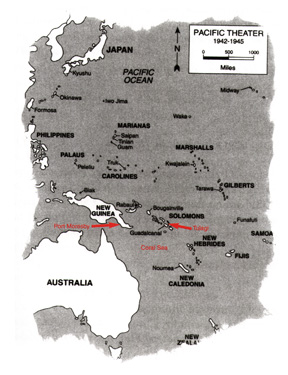 |
||||||||||||||||||
|
|
||||||||||||||||||
| On June 17, 1944 there was enough intelligence information available to cause Adm. Mitscher to believe that the Japanese fleet was coming into the area with the design of sending a series of strike forces against TF-58 then after completing the strike against our ships fly on to its land base on the island of Guam which was then under the control of the enemy. Once on Guam the strike force would refuel and rearm and return to TF-58 carry out another strike and fly on back to its carriers. |
||||||||||||||||||
| On June 18th, 1944 my crew and I manned one of two Avengers and along with two Hellcats, flew long search sectors from our ship probing for evidence of the enemy's position. Shortly before reaching our intended turnaround point in that search we came upon two enemy Zero fighters and an enemy torpedo bomber probably doing the same thing we were dispatched to do. In order to get back to the main story I will simply say we all got back to our ship that day but none of the enemy planes or pilots got back to their ship. With the information gathered from this contact with enemy carrier planes the Admiral now knew our planes and their planes could reach each other. However, there was not a clear definition of the location of the enemy fleet.
The next day, June 19, 1944, search planes were again sent out looking for the fleet. Admiral Mitscher had strike planes on the several carriers in the task force loaded and ready to go at a moments notice. At 4:00 pm one of the search planes reported a contact and sent the message "Enemy force sighted" and proceeded to give the position of the force. |
||||||||||||||||||
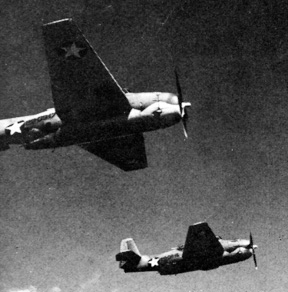 |
||||||||||||||||||
|
|
||||||||||||||||||
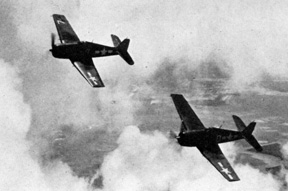 |
||||||||||||||||||
| This position report was immediately established on the ship's charts by the ship's navigator and he wrote a figure on a slip of paper representing the number of miles that the enemy force was from TF-58. This information was carried to Admiral Mitscher by his staff. His first inquiry of his staff was whether our planes could reach the enemy and have enough fuel to return. His staff informed him that it would be close and would involve night operations in taking the returning planes back aboard. Admiral Mitscher then gave the order to the carriers involved to launch the first strike force of approximately 100 planes against the enemy fleet and then prepare the decks for a possible second launching. |
||||||||||||||||||
| Torpedo pilots and their crew had been in their ready rooms all day well aware of the activity of the search planes. Seven of our planes had been loaded with aerial torpedoes in anticipation of a contact being made. Pilots and crew knew by schedule at the front of the ready room who would be on the first launch. Sometime prior to 4:00 pm the decision had been made that the aerial torpedoes should be unloaded and 4 -500 lb. semi-armour piercing bombs be placed in the bombays of the Avengers. | ||||||||||||||||||
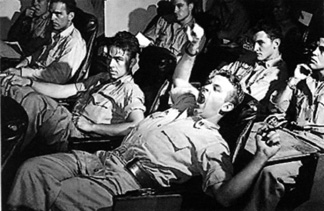 |
||||||||||||||||||
|
Front Row, L to R: Pappy Wilson, Buzz Thomas and Kent Cushman. Back Row, L to R: Mac, Tom and Delgado |
||||||||||||||||||
| This is the load that would have been used the next day as strikes against the enemy ground installations and troops would have continued. Armed with bombs rather than torpedoes changed drastically the nature of the attack as far as the torpedo pilots were concerned. This meant we would be doing glide bombing which calls for a different game plan than that of an aerial torpedo attack against shipping. |
||||||||||||||||||
| When Admiral Mitscher told his staff to send out the order to launch planes this in turn started a network of commands through the air officer on every carrier involved in the TF. Within minutes we received in our ready room the familiar order "Pilots man your planes." I along with Clint Swanson, Norm Sterrie, Bill Linn, Kent Cushman, Mac McLellan and Buzzie Thomas and our crews buckled on our flight gear that we had either hanging on us or near at hand all day and proceeded up the familiar passage ways and ladders one deck up to the Flight Deck and assumed our positions in our planes and readied them for starting. |
||||||||||||||||||
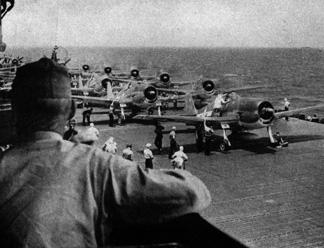 |
||||||||||||||||||
|
Ctsy: Life Mag., dated 6/17/44 |
||||||||||||||||||
| Within a few more minutes the order "Start Engines," came booming across the flight deck. From this point on, what happens on the deck of a carrier is enough to make your spine tingle and your adrenaline to really flow. Every movement of an airplane on a carrier deck during launch is controlled by the signals and motions of a deck hand to the pilot. The pilot must follow those instructions. There are no independent decisions of the pilot as to where or when or how fast he will taxi his plane. The entire launch of a strike group is a series of sequences of motion not unlike an intricately choreographed production. |
||||||||||||||||||
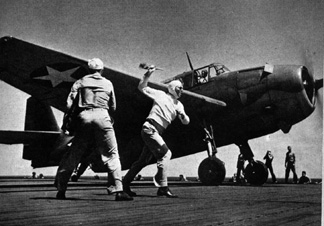 |
||||||||||||||||||
|
Official Navy Photo |
||||||||||||||||||
|
Chapter 3— End of Page 2 of 7 Pages — Go to Page 3 Page —1 — 2 — 3 — 4 — 5 — 6 — 7 Or This Story’s Cover Page — Editor’s Introduction — Table of Contents Fred Gwynn’s “Torpedo 16” — Chapter — 1 — 2 — 3 — 4 Or Home - Contact Us - Cold War Hist. - 91st SRS Hist. - Stardust 40 Mission Story |
||||||||||||||||||